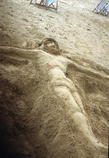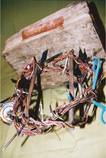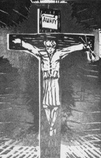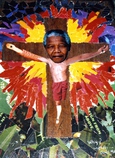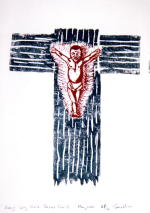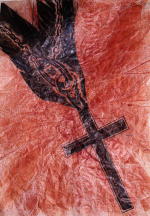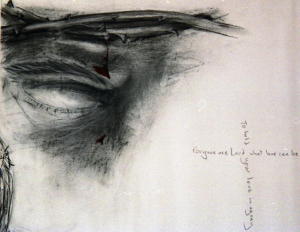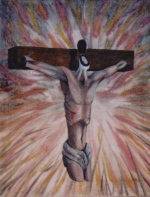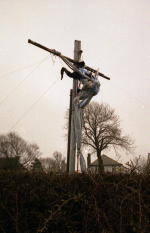
Crucifixation
Around the time of the new millennium I suddenly noticed that a dying man had been tortured and put on display in the street. I then became aware that there was not just one but many of them. I was not going mad and the things I saw were not living things but were merely representations of them. I had seen these many times before but for some reason I had suddenly seen them differently. I thought about why this was and how strange these images were. That then led me to think about what these images meant and how people related to them. In turn these thoughts eventually led to a series of art works that included an exhibition at a local church in the build up to Easter 2002. I have included some of the images here with notes as well as a narrated slideshow.
One of the first things I did was to try and re-sensitize myself to the image, to actually notice the pain and drama that was there in front of me. This led me to produce simple paintings of Christ’s face and feet. I then became aware that I had already made a mistake in depicting Christ as a European male. This was an issue that I could have been distracted by and I could have justifiably begun to explore ethnicity but instead I decided to continue to explore the pain.
In a way I wanted to test out if people were desensitized to the image or if it was just me. One way I did this was with a sand sculpture on a popular beach. I made an image of the crucifixion then walked away to return just a few moments later. I would then go up to the people who gathered to look at it and asked them what they thought, they liked it, I would then say that I had made it and I would enjoy the praise given me. More than once I had people congratulate me and say that there should be more of that sort of thing around. My response to anyone who gave me praise was to say ‘thank you, I wasn’t sure whether to do that or a sculpture of a knife attack’ to which the response was always to look at me like I was mad and tell me that I couldn’t make things like that where children were. This proved my theory that people were not seeing the horror of the slow, tortured murder of an innocent man even when it is right under their noses.
One of the items I made was a modern day crown of thorns. Only one image remains of this. I made it from copper and it included a range of modern objects that people could relate to as being painful from their own experience – the sharp edge from the lid of a tin of beans, open scissors, razor blades etc.
Having made something that I felt helped people identify with a fraction of the pain I wanted to challenge the image of the person on the cross itself. There is something about Christ being the Son of God that makes Him a bit special. We are used to the idea that He did that – we are told that that was why He had come – it was His job. But what if it wasn’t Him. How do you get any sense of not being able to understand why this was happening? My first work aimed at this was a bit of a pun with the function of rattling the believer’s view and opening up the concept for the non-believer – What if it was not the Christ but was the Aunty Christ instead?
The next work on this aspect was a lot more difficult for me, and is one I still feel awkward about. I wanted to introduce the concept of how it would be if someone in today’s world had this happen to him or her. I needed a figure that was familiar enough to be recognized yet someone for whom crucifixion would make no sense at all. I needed to find someone who people would have to ask ‘why have you done this to them’. I decided that it would have to be a collage of body parts from different people with a mix of gender and race but that the face would have to be that key person. After a lot of discussion and thought and agonizing consideration it seemed that there was only one person to which (and this says a lot in many ways) nobody didn’t say they deserved to be crucified – which means even when considering people like princess Diana and Ghandi there were people who had verbalized views that they deserved to be crucified.
I then decided that if I was going to use the image of this person I needed to be open about it. With this in mind I wrote to Nelson Mandala and explained what I wanted to do and what my reasons were. This was not meant as an insult to him nor was it hero worship of him, it was an attempt to encourage people to consider the pain they cause others and to reflect on that question ‘why?’ when there is no real good reason for it. The result of this letter was a response from his office that included newspaper cuttings, photographs and a copy of the book ‘Many Cultures –One Nation’. It was one of the photographs that I used in the final piece that was a collage on wood. The wood is visible as the cross itself and was the top part of a school desk which is another place where one should be asking ‘why?’
Having expressed those views I wanted to take the point in another direction. If we are so desensitized to this image how can I show that to people? I didn’t just want to re-sensitize people to the image I wanted people to be aware that they were desensitized and I wanted them to consider what they were doing with the image. When I was an adolescent I bought a crucifix from a monk in Buckfast abbey. Even at the time I enjoyed the irony that the monk had reduced the price because the Christ had been broken and had been repaired, I didn’t say anything but thought that that should have put the price up because of the symbolic potential it had. If we were not to see who was on the cross, if the form that was there could be of the wrong ethnicity and made of plastic repaired by glue then why not take it to the extreme? So I removed the Christ from the cross (how many people can say that sentence?) and decided to replace it with a Barbie doll. As with the issue I had with Nelson Mandala I felt it right to write to Barbie and outline my intentions. I would like to say that Barbie wrote back with photographs and a book but I got no reply – which I took as not being an objection so I carried on. As a point of interest there were two works I worried might cause too much offense, one was the ‘Aunty christ’ and the other was the ‘Toilet headed Christ’ but it was this one that caused most objection from those who felt that the image on the cross should be that of Christ – even if the image they used was factually inaccurate and that the use of a European white man as the image of the son of God had been used as a way of defending the unfair dominance of other races and genders for hundreds of years and is still used today – even the wound in His side is often on the wrong side!
Having made that point I wanted to bring Christ back into the picture but in a different way. For sometime it had fascinated me how many churches seem to worship three different Christs, one of the Christs having a different name. There is the Christ that gets crucified and the Christ that teaches and the one with the special name ‘baby Jesus’. The first two relate to each other but baby Jesus gets a special place of being this cute image that we all are supposed to feel warm about at Christmas. I must confess to having great urges when people talk about the glory of the nativity to quietly say ‘you do know how the story ends don’t you - spoiler alert’? When looking at this image try singing the title to a well known song – and ‘Mary’s boy child Jesus Christ’ was killed on Christmas day (it just took about 30 years to do it).
Again having made a point I wanted to take it further and change direction a bit. I wanted to challenge the way that people held on to the image and how it was used. The first two were illustrations of concrete poems I had written – ‘Forgive me Lord what love can be to hold Your Love in agony’ and ‘Lord what must you think of me to wear Your DEATH as jewelry’.
The ‘Toilet headed Christ’ was the work I had expected to cause trouble. I wanted to confront and challenge but I didn’t want to push it to the point whereby people closed their minds to it even more. I was not confronting for the sake of confronting. Before the exhibition my wife suggested that our elderly Christian neighbor – who I respect greatly – would be upset by this image, so I went round and talked to her to find her surprisingly pleased at what I had done.
The image is of part of a human body on a cross with an open, used toilet as a head. The reason for it only being part of a body is to show that this image doesn’t give the full picture – there is more to it than just this message. The toilet represents how many people use religion and ceremony. People bring their rubbish, their sin, their guilt and their mistakes and then feel they can flush them away and return to repeat them again and again. This may be the token confession of an angry thought or the abuse of children and others by the church itself. I am not saying it is wrong to confess, to ask forgiveness or that we don’t all make mistakes but to put on Sunday best once a week and do nothing else but hide behind religious ceremony is to use faith as a toilet.
Finally, IF there is any truth in the image of the crucifixion, IF there is any value in it what would I see it as? Possibly my favourite work in the series. This was on display at the time of the exhibition but was on the road going to the church. The fact that it was not in the church is relevant because I do not believe that the church is faith – even if the church is in faith. Faith is not a building or a group or a set of rituals. The road is a busy public road and as such is available openly to everyone – as it should be, unlike the church that is locked when not in use. Most people drove past without looking, some mistook it as something else but some noticed. The sculpture was entirely made from rubbish to represent the sin He carried and was covered in lard and grain. So whilst most people drove by with their busy lives there were moments when the road was empty, moments of quiet. During those quiet moments birds, who had no religious study and had not joined any holy order or formed any army to spread any ‘good word’, descended upon the sculpture and fed from it gaining strength and life and pleasure.


